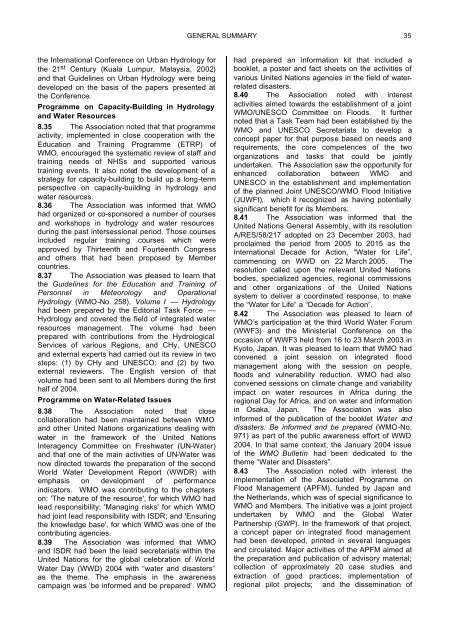Regional Association II (ASIA) - E-Library - WMO
Regional Association II (ASIA) - E-Library - WMO
Regional Association II (ASIA) - E-Library - WMO
You also want an ePaper? Increase the reach of your titles
YUMPU automatically turns print PDFs into web optimized ePapers that Google loves.
GENERAL SUMMARY 35the International Conference on Urban Hydrology forthe 21 st Century (Kuala Lumpur, Malaysia, 2002)and that Guidelines on Urban Hydrology were beingdeveloped on the basis of the papers presented atthe Conference.Programme on Capacity-Building in Hydrologyand Water Resources8.35 The <strong>Association</strong> noted that that programmeactivity, implemented in close cooperation with theEducation and Training Programme (ETRP) of<strong>WMO</strong>, encouraged the systematic review of staff andtraining needs of NHSs and supported varioustraining events. It also noted the development of astrategy for capacity-building to build up a long-termperspective on capacity-building in hydrology andwater resources.8.36 The <strong>Association</strong> was informed that <strong>WMO</strong>had organized or co-sponsored a number of coursesand workshops in hydrology and water resourcesduring the past intersessional period. Those coursesincluded regular training courses which wereapproved by Thirteenth and Fourteenth Congressand others that had been proposed by Membercountries.8.37 The <strong>Association</strong> was pleased to learn thatthe Guidelines for the Education and Training ofPersonnel in Meteorology and OperationalHydrology (<strong>WMO</strong>-No. 258), Volume I — Hydrologyhad been prepared by the Editorial Task Force —Hydrology and covered the field of integrated waterresources management. The volume had beenprepared with contributions from the HydrologicalServices of various Regions, and CHy, UNESCOand external experts had carried out its review in twosteps: (1) by CHy and UNESCO; and (2) by twoexternal reviewers. The English version of thatvolume had been sent to all Members during the firsthalf of 2004.Programme on Water-Related Issues8.38 The <strong>Association</strong> noted that closecollaboration had been maintained between <strong>WMO</strong>and other United Nations organizations dealing withwater in the framework of the United NationsInteragency Committee on Freshwater (UN-Water)and that one of the main activities of UN-Water wasnow directed towards the preparation of the secondWorld Water Development Report (WWDR) withemphasis on development of performanceindicators. <strong>WMO</strong> was contributing to the chapterson: 'The nature of the resource', for which <strong>WMO</strong> hadlead responsibility; 'Managing risks' for which <strong>WMO</strong>had joint lead responsibility with ISDR; and 'Ensuringthe knowledge base', for which <strong>WMO</strong> was one of thecontributing agencies.8.39 The <strong>Association</strong> was informed that <strong>WMO</strong>and ISDR had been the lead secretariats within theUnited Nations for the global celebration of WorldWater Day (WWD) 2004 with “water and disasters”as the theme. The emphasis in the awarenesscampaign was ‘be informed and be prepared’. <strong>WMO</strong>had prepared an information kit that included abooklet, a poster and fact sheets on the activities ofvarious United Nations agencies in the field of waterrelateddisasters.8.40 The <strong>Association</strong> noted with interestactivities aimed towards the establishment of a joint<strong>WMO</strong>/UNESCO Committee on Floods. It furthernoted that a Task Team had been established by the<strong>WMO</strong> and UNESCO Secretariats to develop aconcept paper for that purpose based on needs andrequirements, the core competences of the twoorganizations and tasks that could be jointlyundertaken. The <strong>Association</strong> saw the opportunity forenhanced collaboration between <strong>WMO</strong> andUNESCO in the establishment and implementationof the planned Joint UNESCO/<strong>WMO</strong> Flood Initiative(JUWFI), which it recognized as having potentiallysignificant benefit for its Members.8.41 The <strong>Association</strong> was informed that theUnited Nations General Assembly, with its resolutionA/RES/58/217 adopted on 23 December 2003, hadproclaimed the period from 2005 to 2015 as theInternational Decade for Action, “Water for Life”,commencing on WWD on 22 March 2005. Theresolution called upon the relevant United Nationsbodies, specialized agencies, regional commissionsand other organizations of the United Nationssystem to deliver a coordinated response, to makethe “Water for Life” a “Decade for Action”.8.42 The <strong>Association</strong> was pleased to learn of<strong>WMO</strong>’s participation at the third World Water Forum(WWF3) and the Ministerial Conference on theoccasion of WWF3 held from 16 to 23 March 2003 inKyoto, Japan. It was pleased to learn that <strong>WMO</strong> hadconvened a joint session on integrated floodmanagement along with the session on people,floods and vulnerability reduction. <strong>WMO</strong> had alsoconvened sessions on climate change and variabilityimpact on water resources in Africa during theregional Day for Africa, and on water and informationin Osaka, Japan. The <strong>Association</strong> was alsoinformed of the publication of the booklet Water anddisasters: Be informed and be prepared (<strong>WMO</strong>-No.971) as part of the public awareness effort of WWD2004. In that same context, the January 2004 issueof the <strong>WMO</strong> Bulletin had been dedicated to thetheme “Water and Disasters”.8.43 The <strong>Association</strong> noted with interest theimplementation of the Associated Programme onFlood Management (APFM), funded by Japan andthe Netherlands, which was of special significance to<strong>WMO</strong> and Members. The initiative was a joint projectundertaken by <strong>WMO</strong> and the Global WaterPartnership (GWP). In the framework of that project,a concept paper on integrated flood managementhad been developed, printed in several languagesand circulated. Major activities of the APFM aimed atthe preparation and publication of advisory material;collection of approximately 20 case studies andextraction of good practices; implementation ofregional pilot projects; and the dissemination of
















